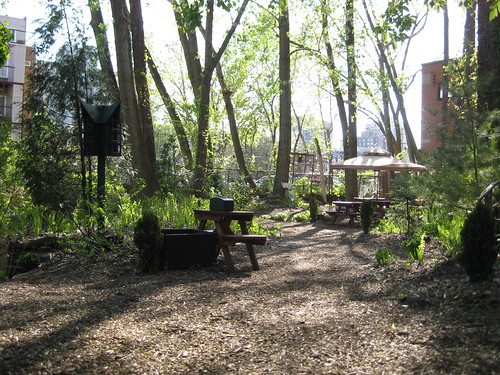One of the gardeners is tattooed from head to toe: his face is a grimacing skull and, under a loose tank top, demons claw through the flesh of his torso, exposing pale ribs. The third graders at Garneau elementary school stare unabashedly at this creature, who would seem more suited to the pages of a comic book then their playground. But his blue eyes sparkle from the depth of their black-ink sockets as he leads the kids into the flower garden.
He is one of ten young people employed by Sentier Urbain, a non-profit with a focus on “social greening.” Each summer, Sentier Urbain hires youth with a history of drug-use, homelessness, and mental health to help landscape and maintain half a dozen thematic gardens in the east-end of Montreal. They also build flower boxes and grow seedlings for local businesses and social housing projects, and partner with École Garneau to run a gardening program.
Some of the school kids are reluctant to put their hands in the dirt at first. Their school yard was – until recently – a concrete lot, fenced with chain-link, facing the off-ramp of the Jacques Cartier Bridge. Now they have apple trees on the roof, a classroom turned into a nursery, and flower garden in the school yard. Today, they will plant seedlings they sprouted over the winter.
One little girl says she’s reminded of her grandfather’s garden back in Bangladesh; another chatters about the tomatoes her mother grows on the balcony of their apartment building. By the time the recess bell rings, the kids are ready to hug their punkish mentors and brazenly reach out to touch their tattoos.
A Secret Garden
I met Pierre Dénommé, Sentier Urbain’s founder and director, in a tiny garden on rue Panet. Behind a thin veil of leaves, I can see the balconies and fire escapes of apartment buildings, a dull parking lot, the brick walls of an old factory. And yet I feel as though I have been transported far from the city.
It’s only later that I realize the difference: it’s the feeling of earth under my feet. When’s the last time my feet touched anything but concrete, manicured lawn, or packed dirt where the grass has run thin? In this tiny downtown lot, the ground is alive.
Dénommé recounts that, when the organization began to work in an abandoned lot on Ste Catherine Street last summer, they didn’t find a single bug in the dirt. Over the summer, they layered almost two feet of compost, leaves and soil on the lot. By September, Dénommé boasts, there were earthworms the size of garter snakes.
« It’s something that you’d see in the forest, but not in landscaping,” Dénommé says, pointing out how cedars, spruce trees, and ferns grow all together in a dense thicket rather than in well-maintained rows. “For me, it’s not the individual tree that matters, but the composition that is important, recreating as much as possible something that is similar to nature.”
“Some people find it messy,” he adds.
But there is some method to the tangled gardens, and they offer thematic educational programs for schools, summer camps, and the public (some of the gardens are on city land, and others are lent by private owners). The garden on Panet teaches about composting as well as ornithology, with bird feeders, a chicken coop, and some resident caged doves. A second garden presents some elements of Native American culture and has a puppet theatre, creatively animated by the punk gardeners, while a third specializes in medicinal plants and berries. Dénommé says that kids adore eating raspberries, blueberries, grapes and pears fresh off the branch.
“We’re in an underprivileged neighbourhood,” Dénommé points out, “there are lots of kids who don’t have a chance to get out and experience this kind of atmosphere.”
But cultivating an urban wilderness comes with a price: all Sentier Urbain’s gardens are fenced and padlocked, only open to the public during certain hours under supervision.
Dénommé says they have no choice. “If the city designs their parks to be pruned, without bushes, it’s because of the problems common to the downtown area: prostitution, drug-use, incivility.”
“These aren’t places that we can leave open to the public because…imagine what could happen here at midnight,” he says. He describes that, before Sentier Urbain began cultivating the lot on Beaudry and Ontario, four or five hookers walked the corner day and night using the overgrown lot to turn tricks. Sometimes people still jump the fence at night and shoot up beside the goldfish pond. When this happens they place a needle box on hand and after 3 or 4 days at least they no longer fear finding used needles on the ground.
At least, with Sentier Urbain’s socio-professional reinsertion program, marginalized youth from the rough streets of the Centre Sud’s East side do get to grow roots among bugs, flowers, birds and children, as well as benefit from counselling and job training.

Towards the end of our interview, a spotted rabbit named Bella hops across the garden path. Dénommé says she wanders all over the neighbourhood and plays with the house cats, but always comes back to the garden on Panet.
I guess I shouldn’t be surprised: where else in this concrete neighbourhood would a rabbit want to be?
Sentier Urbain’s gardens open to the public starting this week, Tuesdays and Thursdays from 9am-4pm. In July and August, the gardens on Panet and Sainte Catherine will be open Tuesday-Sunday. See their website for more info about other “social greening” projects in the Plateau and Montréal Nord.
Most of the above photos were taken in 2009.




2 comments
LOVE it.
This is awesome. It’s exciting to hear about it!